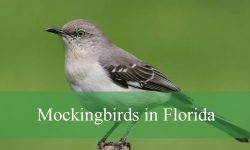Michigan’s wetlands, lakes, and rivers are home to a remarkable diversity of herons and egrets. These graceful wading birds play an important role in wetland ecosystems and are a favorite among birdwatchers for their striking appearances and hunting behaviors.
Across the state, 12 different species of herons have been recorded. Some, like the Great Blue Heron and Green Heron, are commonly seen, while others such as the Tricolored Heron and Reddish Egret appear only as rare visitors. Each species brings unique traits that make them fascinating to observe.
This guide introduces the 12 types of herons found in Michigan, complete with pictures and identification tips. By understanding their features, habitats, and seasonal movements, bird enthusiasts can enjoy more rewarding experiences when exploring Michigan’s wetlands and waterways.
Different Types of Herons Found in Michigan
Great Blue Heron (Ardea herodias)
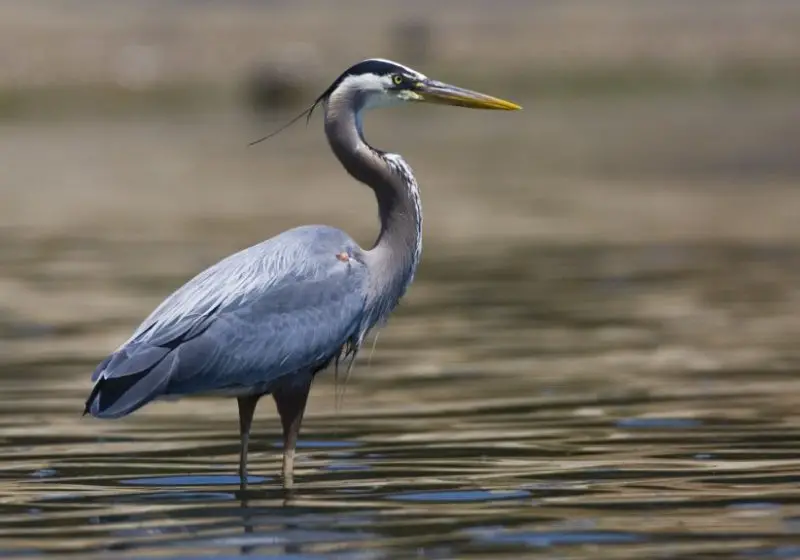
The Great Blue Heron is the largest and most widespread heron in Michigan, standing about four feet tall with a wingspan of up to six feet. Its slate-blue feathers, long legs, and dagger-like yellow bill make it easy to recognize even from a distance. During flight, it tucks its neck into an S-shape, a distinctive feature that separates it from cranes.
This species is most commonly found near lakes, rivers, marshes, and wetlands across Michigan. They are highly adaptable and can be spotted in both rural and urban settings, from inland ponds to coastal areas along the Great Lakes. They are year-round residents in southern Michigan, though many migrate south during the harshest winter months.
Great Blue Herons are expert hunters, feeding primarily on fish, but they also consume amphibians, reptiles, insects, and small mammals. They use a slow, stealthy approach, often standing motionless before striking swiftly with their sharp bill. Their patience and precision make them one of the most efficient predators in wetland ecosystems.
During breeding season, they nest in colonies called rookeries, usually high in trees near water. These nests are large platforms built from sticks and reused for several years. Courtship involves dramatic displays of wing spreading and bill snapping. Their presence is often considered an indicator of a healthy aquatic environment.
Great Egret (Ardea alba)
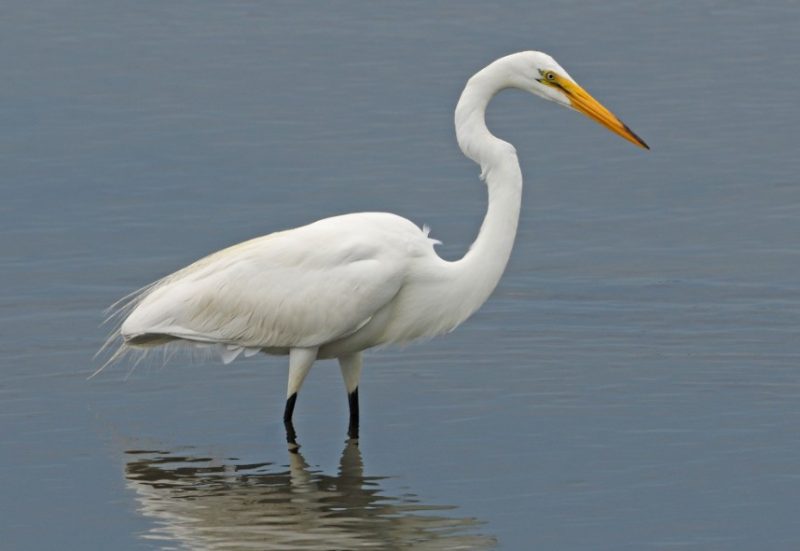
The Great Egret is a striking bird known for its pure white plumage, long black legs, and bright yellow bill. Slightly smaller than the Great Blue Heron, it still reaches an impressive height of over three feet. In flight, its long neck is tucked in the same way as other herons, making identification easier for birdwatchers.
This elegant bird is more common in southern Michigan but can be seen throughout the state during migration seasons. They prefer shallow wetlands, marshes, and shorelines where fish and amphibians are abundant. While less common than Great Blue Herons, their populations in Michigan have grown steadily in recent decades.
Great Egrets feed by wading slowly through shallow waters, striking quickly at prey such as fish, frogs, and insects. Their graceful movements make them one of the most admired waders in the state. In summer, they can often be spotted standing motionless, glowing in the sunlight against green marsh vegetation.
During breeding, their long lacy plumes, once highly prized by the fashion industry, become especially prominent. These feathers nearly led to their extinction in the late 19th century due to plume hunting. Today, thanks to conservation efforts, Great Egrets are protected and serve as a symbol of bird conservation success.
Green Heron (Butorides virescens)
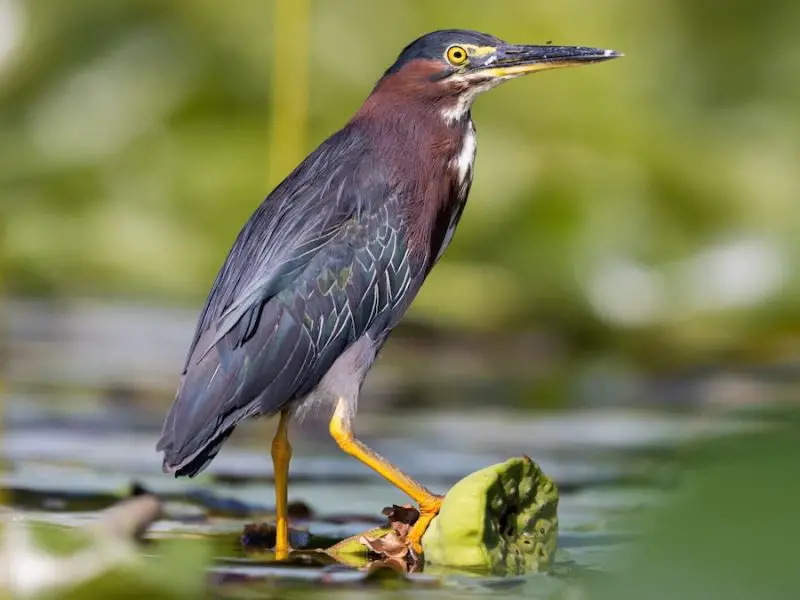
The Green Heron is a smaller, stockier heron species, usually standing around 18 inches tall. It has a dark greenish back, chestnut-colored neck, and a short crest that can be raised when alert. Its compact size and secretive nature often make it more difficult to spot than larger herons.
In Michigan, Green Herons inhabit wooded swamps, streams, ponds, and marshes. They prefer areas with dense vegetation near shallow water, where they can remain hidden while hunting. They are most active during dawn and dusk, making quiet observers more likely to encounter them in these hours.
Unlike other herons, Green Herons are famous for their use of tools. They have been observed dropping insects, feathers, or small twigs onto the water’s surface to lure fish within striking range. This clever behavior showcases their intelligence and sets them apart from most other wading birds.
Their nests are usually built in shrubs or small trees close to water. Green Herons are monogamous during the breeding season, with both parents sharing the responsibility of incubating eggs and feeding the young. Their distinct, sharp “skeow” call often gives them away even before they are seen.
Black-crowned Night-Heron (Nycticorax nycticorax)
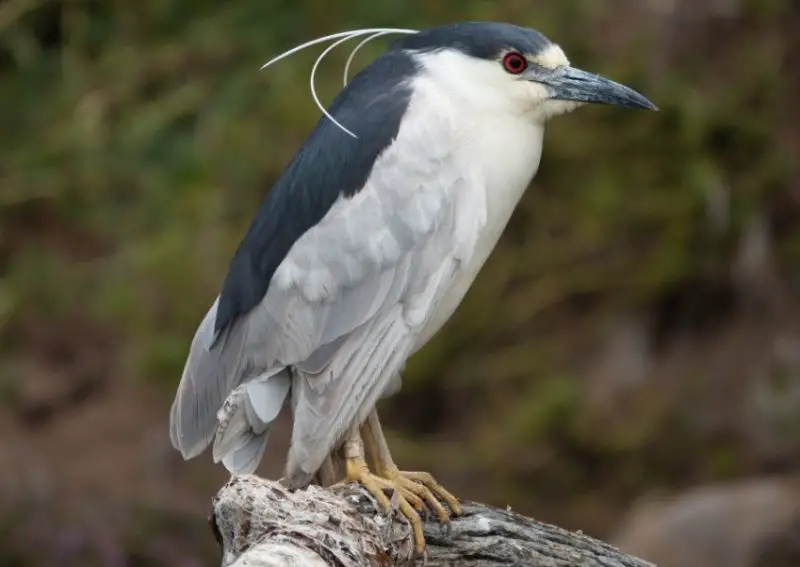
The Black-crowned Night-Heron is a medium-sized heron with a chunky body, short legs, and a thick neck. Adults have striking black caps, gray wings, and red eyes, while juveniles are brown and heavily streaked, resembling a completely different species. Their stocky build and hunched posture make them easy to identify compared to taller, slimmer herons.
True to their name, these herons are most active during dusk and night. In Michigan, they inhabit marshes, riverbanks, and lakeshores, often roosting in colonies during the day before emerging to feed at night. They are fairly widespread but more secretive than the Great Blue Heron, making sightings less common.
Their diet includes fish, crustaceans, amphibians, and small mammals. They hunt by standing still or slowly stalking prey, then striking quickly with their sharp bill. Nighttime activity reduces competition with daytime hunters like Great Blue Herons and Green Herons.
Black-crowned Night-Herons breed in colonies, often with other wading birds. Their nests are built in trees, shrubs, or reed beds close to water. During courtship, males perform displays that include bowing and bill clapping. The presence of these herons in Michigan wetlands highlights the diversity of heron species across the state.
American Bittern (Botaurus lentiginosus)
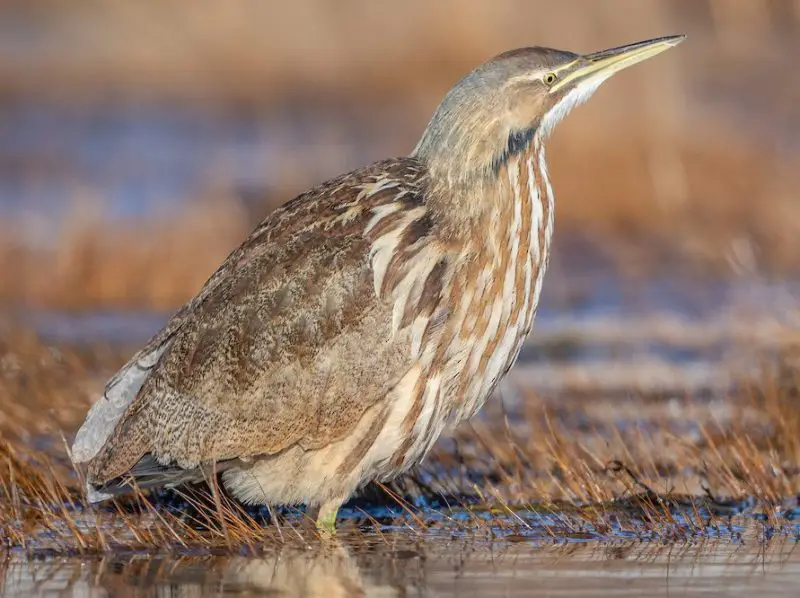
The American Bittern is a medium-sized, stocky heron with mottled brown and buff plumage that blends perfectly with marsh reeds. Its long neck and pointed bill are often held straight up, giving the bird a reed-like appearance. This camouflage makes it one of the most challenging herons to spot in Michigan wetlands.
This species prefers large, freshwater marshes, wet meadows, and cattail-dominated habitats across Michigan. It is more often heard than seen, especially during the breeding season when males produce their distinctive “pump-er-lunk” call. These booming sounds carry long distances and are a reliable way to detect their presence.
American Bitterns are solitary hunters, feeding on fish, amphibians, crayfish, insects, and small mammals. They stalk prey slowly, relying on patience and their ability to remain nearly invisible among dense vegetation. When alarmed, they freeze with bills pointing upward, swaying gently with the reeds to avoid detection.
Nesting occurs in thick marsh cover, usually on platforms built from reeds and grasses. The female incubates a clutch of eggs and raises the young with little assistance. Their strong dependence on wetland habitats makes them vulnerable to habitat loss, and they are considered a species of conservation concern in many parts of North America.
Least Bittern (Ixobrychus exilis)
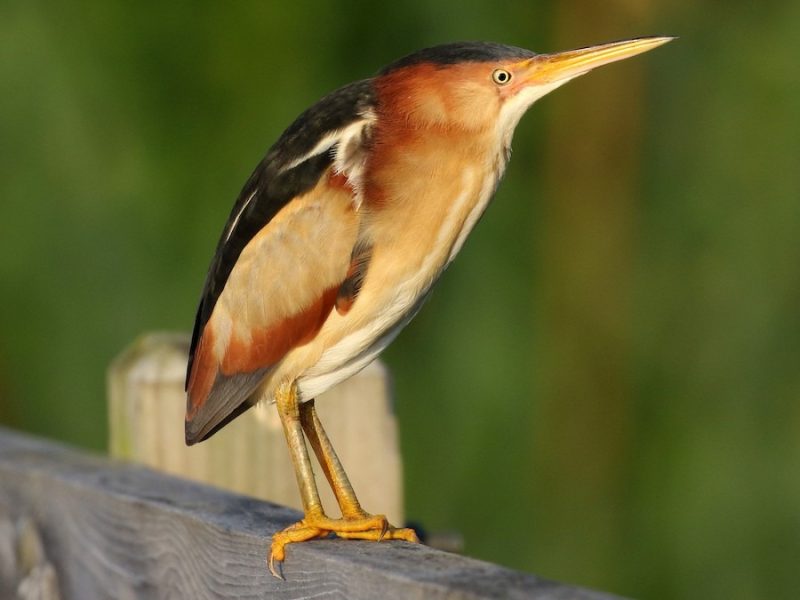
The Least Bittern is the smallest member of the heron family in Michigan, measuring only about 11–14 inches in length. Its chestnut and buff-colored plumage with dark greenish-black crown and back allows it to disappear into cattails and reeds. Despite its small size, it has a surprisingly loud voice, especially during the breeding season.
This species inhabits dense cattail marshes, particularly in southern Michigan. They are very secretive, spending most of their lives hidden among tall reeds. Birders often hear their soft “coo-coo-coo” or “reek” calls long before getting a glimpse of them. Even when flushed, they tend to fly only short distances before dropping back into cover.
Least Bitterns are agile hunters, capable of clinging to reeds with long toes and straddling stems to reach prey. Their diet includes fish, insects, frogs, and other small aquatic creatures. Their unique hunting technique of balancing between reeds allows them to access areas where larger herons cannot forage.
They build small, well-hidden platform nests above the water surface using cattail stems. Both parents share incubation duties and feeding of the chicks. Due to their reliance on intact wetland habitats, Least Bittern populations are declining in some regions, making them a priority species for wetland conservation efforts.
Snowy Egret (Egretta thula)
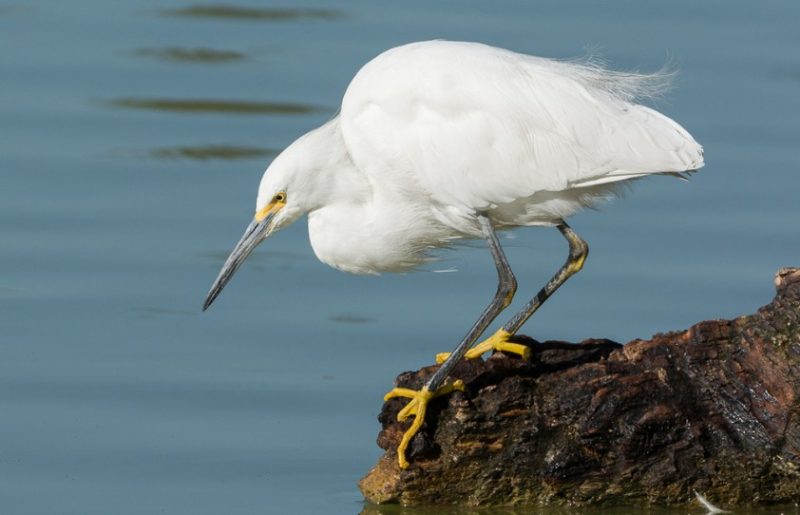
The Snowy Egret is a graceful, medium-sized heron easily recognized by its pure white plumage, slender black bill, black legs, and striking yellow feet. These bright yellow toes are a key field mark, often seen as they stir the water to flush out prey. Their elegant appearance makes them one of the most admired wading birds in North America.
In Michigan, Snowy Egrets are considered uncommon visitors, mostly seen during migration. They appear occasionally in southern parts of the state near marshes, lakes, and rivers. While not regular breeders in Michigan, they may join mixed colonies of other herons and egrets when conditions are favorable.
Snowy Egrets feed on small fish, crustaceans, and insects. They often use active foraging techniques, running through shallow water, stirring mud with their feet, or even hopping to chase prey. Their energetic style contrasts sharply with the slow, deliberate hunting of larger herons.
During breeding season, they develop long, lacy plumes on their backs and necks, which were once highly sought after for the feather trade. Today, their populations have recovered thanks to strong protections. Occasional sightings in Michigan are always exciting for birders given their elegance and rarity in the region.
Cattle Egret (Bubulcus ibis)

The Cattle Egret is a small, stocky white heron with a yellow bill and relatively short legs compared to other egrets. In breeding plumage, it displays golden-orange feathers on its crown, breast, and back. Originally native to Africa and Asia, this species has expanded dramatically across North America in the last century.
In Michigan, Cattle Egrets are considered rare visitors. They are most often seen in agricultural areas, fields, and pastures where they follow livestock or farm machinery to catch insects and small vertebrates stirred up from the ground. Unlike other herons, they are just as comfortable hunting on dry land as they are near water.
Their diet consists mainly of grasshoppers, crickets, frogs, and small reptiles. This opportunistic feeding behavior makes them highly adaptable, contributing to their success in colonizing new areas. Their association with cattle and farm animals gives them their common name and makes them easy to identify in the right habitat.
When breeding, Cattle Egrets gather in colonies, sometimes alongside other herons and egrets. They nest in trees or shrubs near wetlands. Though uncommon in Michigan, their occasional appearances highlight the adaptability of herons and the possibility of new species expanding their range northward.
Little Blue Heron (Egretta caerulea)
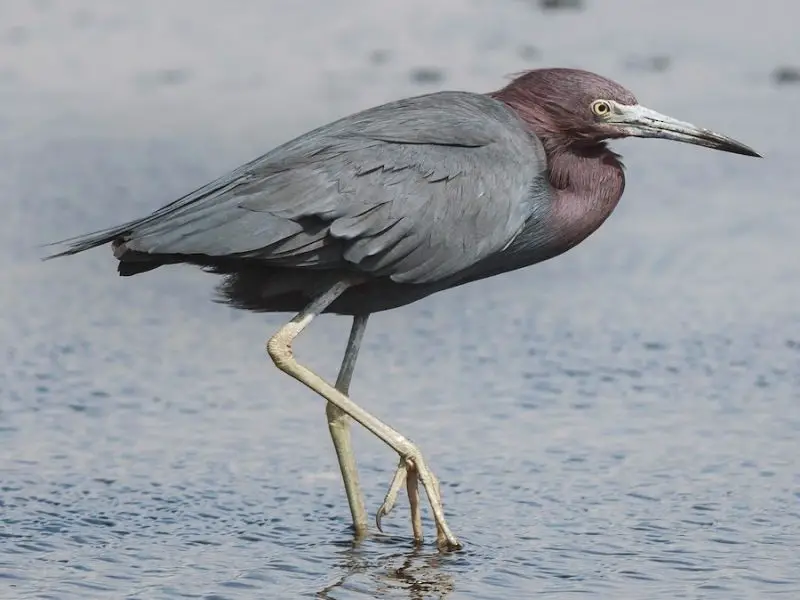
The Little Blue Heron is a medium-sized heron, easily distinguished by its slate-blue body and maroon-purple head and neck in adults. Juveniles, however, are entirely white during their first year, often causing confusion with Snowy Egrets. Over time, their plumage transitions gradually from white to blue, resulting in a mottled appearance during their second year.
In Michigan, the Little Blue Heron is considered a rare or “casual” visitor. Most sightings occur during spring and summer, particularly in southern parts of the state near wetlands, marshes, and lake shorelines. While they do not breed regularly in Michigan, migrating individuals occasionally stop to forage in shallow waters.
These herons primarily feed on fish, frogs, crustaceans, and aquatic insects. Unlike the more active Snowy Egret, the Little Blue Heron tends to hunt slowly and deliberately, patiently stalking prey before striking. This methodical feeding style sets them apart from their more energetic relatives.
When breeding in southern regions of the U.S., they form colonies in trees or shrubs near water, often with other herons and egrets. In Michigan, they are typically observed only as solitary individuals or in small groups. Birdwatchers prize sightings of Little Blue Herons in the state due to their rarity and striking coloration.
Tricolored Heron (Egretta tricolor)
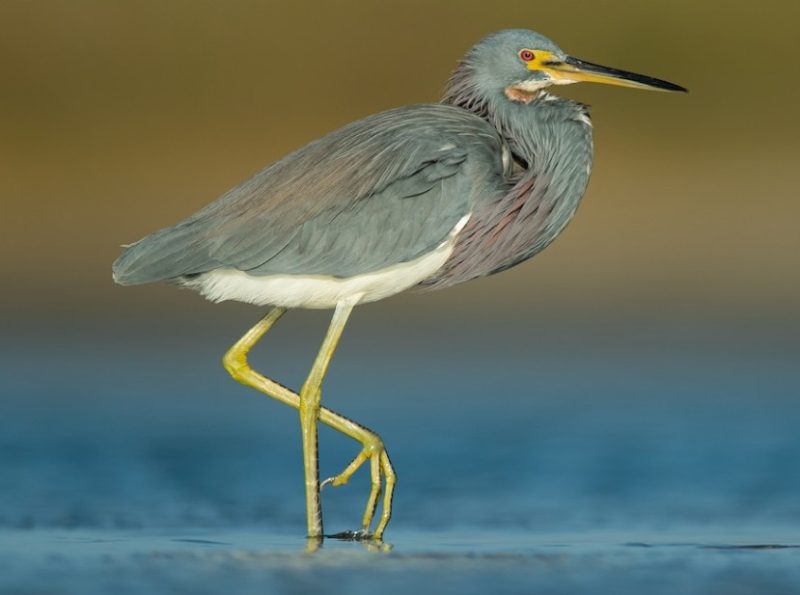
The Tricolored Heron, formerly known as the Louisiana Heron, is a slender, medium-sized bird with a distinctive mix of blue-gray upperparts, white belly, and reddish neck. Its contrasting colors make it one of the most striking herons in North America. The long, sharp bill and graceful build add to its elegant appearance.
In Michigan, the Tricolored Heron is a very rare visitor, usually reported only during migration or after storms push individuals northward. Most sightings occur near the southern Great Lakes, where they forage along shallow shorelines and marsh edges. They are not regular breeders in the state.
These herons feed primarily on small fish, often employing active hunting strategies such as dashing, running, or even spreading their wings to corral prey. Their quick movements and distinctive feeding techniques make them stand out compared to more sedentary herons.
Breeding typically occurs in coastal colonies in the southeastern U.S., where they nest in trees or shrubs over water. While breeding in Michigan has not been documented, occasional vagrant individuals add to the state’s impressive diversity of herons and egrets. Spotting a Tricolored Heron in Michigan is considered a special event for bird enthusiasts.
Yellow-crowned Night-Heron (Nyctanassa violacea)
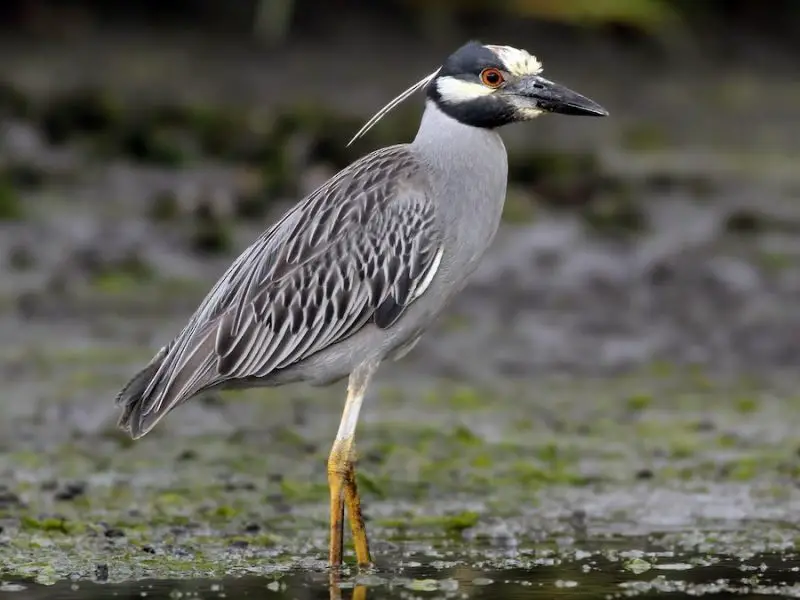
The Yellow-crowned Night-Heron is a medium-sized heron with a robust body, thick neck, and striking plumage. Adults feature a black head with a bold white cheek patch and a pale yellowish crown, while their eyes are large and red, adapted for nocturnal hunting. Juveniles are brown and heavily streaked, resembling young Black-crowned Night-Herons.
This species is extremely rare in Michigan, considered a casual or accidental visitor. Most records come from southern regions of the state near wetlands, rivers, and lake margins. Because of its secretive behavior and limited distribution, sightings are uncommon and often generate excitement among birders.
Yellow-crowned Night-Herons specialize in feeding on crustaceans, particularly crayfish, which are abundant in many aquatic habitats. Their powerful bills allow them to crush hard shells with ease. Unlike many herons that feed during the day, these birds are primarily nocturnal hunters, emerging at dusk.
During breeding season in southern states, they nest in colonies, often in trees over water. They are less common breeders in northern regions, and no established breeding colonies exist in Michigan. Their rare appearances in the state highlight the occasional long-distance movements of herons beyond their typical range.
Reddish Egret (Egretta rufescens)
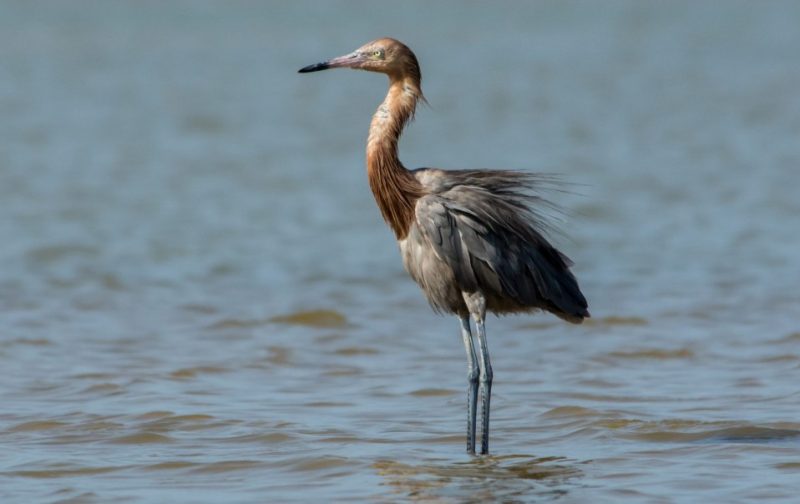
The Reddish Egret is one of the most distinctive and rarest herons to appear in Michigan. Adults have shaggy reddish-brown neck and head feathers with a slate-blue body, while white morphs exist with pure white plumage. Their pinkish bill tipped with black and their active feeding style make them unmistakable when seen.
This species is normally found along the Gulf Coast and southern Atlantic shores, far from Michigan. In the state, it is classified as a very rare vagrant, with only a handful of records in history. Any sighting of a Reddish Egret in Michigan is considered highly unusual and significant.
Reddish Egrets are famous for their unique hunting behavior, often described as “canopy feeding.” They run, spin, and spread their wings in dramatic displays to startle fish into shallow water. This acrobatic foraging style is unlike any other heron and makes them particularly memorable to watch.
Breeding typically occurs in coastal colonies in the southern U.S., Caribbean, and Mexico. Their presence in Michigan is accidental, usually linked to storms or disoriented migration. For birdwatchers, encountering a Reddish Egret in Michigan is a once-in-a-lifetime experience and a highlight in state birding records.
Best Time and Places to See Herons in Michigan
Herons in Michigan are most active and visible during the warmer months, from late spring through early fall. The peak season runs from May to September, when wetlands are teeming with fish, amphibians, and insects that form the bulk of their diet. During these months, birdwatchers have the best chance of spotting both common and rare species across the state.
Southern Michigan offers some of the most reliable locations to observe herons, especially in areas with expansive marshes, lakes, and rivers. Places such as Lake Erie Metropark, Pointe Mouillee State Game Area, and Kensington Metropark are well known for their large heron populations. These wetlands host nesting colonies and provide excellent foraging grounds, making them hotspots for birdwatchers.
In northern parts of the state, including the Upper Peninsula, herons can be seen along lake shorelines and secluded marshlands. Seney National Wildlife Refuge is a notable destination, providing a habitat for American Bitterns, Least Bitterns, and Great Blue Herons. For those seeking rarer sightings, southern wetlands near the Great Lakes remain the most promising locations.
Early morning and late evening are the best times of day to spot herons, as they are actively hunting in shallow waters. Night-herons, such as the Black-crowned and Yellow-crowned species, are easier to observe at dusk when they leave roosting sites to forage. Patience, quiet observation, and binoculars greatly increase the likelihood of successful encounters.
FAQs about Herons in Michigan
How many types of herons are found in Michigan?
Michigan is home to 12 species of herons, egrets, and bitterns, ranging from the common Great Blue Heron to rare visitors like the Reddish Egret and Tricolored Heron.
What is the most common heron in Michigan?
The Great Blue Heron is the most widespread and frequently observed species across the state. It can be found in almost every wetland and along the shores of the Great Lakes.
Are there herons in Michigan during winter?
Most herons migrate south during the harsh winter months. However, some Great Blue Herons may remain year-round in southern Michigan if open water is available for fishing.
Where can I see rare herons in Michigan?
Rare species such as Snowy Egrets, Little Blue Herons, and Tricolored Herons are most often seen in southern wetlands near Lake Erie and Lake St. Clair. These sightings are uncommon but highly rewarding for birdwatchers.
Do herons nest in colonies in Michigan?
Yes. Species like Great Blue Herons and Black-crowned Night-Herons form nesting colonies, known as rookeries, often in tall trees near wetlands. These colonies can contain dozens or even hundreds of nests.






